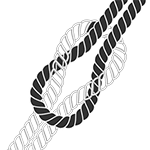How to Identify Quality in Braided Rope, or, Get What You Pay For!
Sighting the Braid
- When selecting a new piece of line, simply sight down its length as you would a plank. If you see broken yarn filaments, high or low strands, corkscrew or roll, randomly uneven yarn color or looped strands; beware!
Broken Yarn Filaments
- This indicates the use of poorly maintained machinery or lack of yarn finish. This defect will result in lower strength (because a portion of the rope is already broken), greater stretch, premature wear and more rapid degradation.
High or Low Strands
- The presence of this defect reveals uneven yarn tensioning in manufacture or use of different yarn sizes. It means that some of the yarns will not be sharing the work equally with the others’ resulting in more stretch at a given load, lower ultimate break strength and more rapid wear.
Looped Strands
- This defect is usually caused by unequal yarn tensioning in the manufacturing process and results in the same problems as mentioned above.
Corkscrew or Roll
- This occurs when the tensions of the yarn in one direction are different from the tensions of the yarn in the other direction. It can also be caused by the use of dissimilar yarns, which have differing shrink or stretch characteristics. One major problem with the presence of this defect is that the line may tend to accept of resist (depending on the direction of the roll) the temporary twist, which is induced in sheets when they are peeled from the top of a winch. If the line doesn’t properly accept twist in this application it will tend to hockle and jam in blocks more frequently.
Randomly Uneven Yarn Color or Sheen
- This is a dead give-away to the use of inferior, odd lot yarns of various types and finished that are likely to result in a variety of problems including uneven wear and premature failure.
Strands Twist
- All braided ropes should be constructed using clockwise and counter-clockwise twisted strands (referred to as “S” twist and “Z” twist in the trade). The reason for this design is to orient all of the fine yarn filaments parallel to the longitudinal axis of the rope allowing them to be combed rather than plucked, snagged and broken when dragged over a rough surface as they would be if they were at an angle or perpendicular to the axis of the rope.
Finished Warns
- Raw yarn can be purchased from a producer with “finish or, for a little less cost, without a “finish”. Finish is the trade name for lubricant that is etched or chemically bonded to the yarn, which dramatically improves its performance. The wet performance of a rope made with Seaguard® finish, for example, can out perform an unfinished rope by as much as 20 times.
Properly Sized Rope
- It is important for a rope to maintain the proper size while under load. Undersized rope presents less surface area to winch and sheave surfaces thereby requiring less yarn to bear more load. Undersized rope may require more wraps to develop the same holding power on a winch. This is especially true when the rope is wet or used in self-tailers. Undersize rope may perform poorly in various cam cleats and halyard stoppers. Check the weight per foot specifications to compare sizes of ropes made with similar materials.
Spliceability
- It is sometimes difficult for the layperson and experienced rigger alike to determine if a rope will be properly spliceable without actually performing the task. A high quality rope is engineered to accomplish a balance of purpose between the double braided cover and core, resulting in uniform spliceability whether the rope is new or used. One simple test, which may indicate an imbalance between cover and core, is to coil the rope. If it does not coil uniformly, bends more sharply in some places or resists coiling altogether, you should question the rope’s quality.
Braider Splices
- Some manufacturers use undersize braiders to produce rope. While smaller braiders may run faster and are less expensive to buy, rope produced on them will contain many yarn and strand splices in a given length. Splices can sometimes be seen in the cover strands, but are hidden in the core. Premium quality rope, like Yale Cordage, New England Rope, and Samson do not allow braider splices in the core or cover of 600-foot spools.
Cleanliness
- There is no reason to accept rope from a manufacturer with grease or oil spots. While it may no seriously affect performance, it is an indication of lack of commitment of quality and inspection.
Value
- The rope suppliers Rope inc. purchases rope from are committed to providing the highest quality rope products available designed to deliver maximum performance and durability.
® Seaguard is a registered trademark of Allied Fibers
![]()
This information was taken from a bulletin supplied by Yale Cordage, Biddeford, Maine



